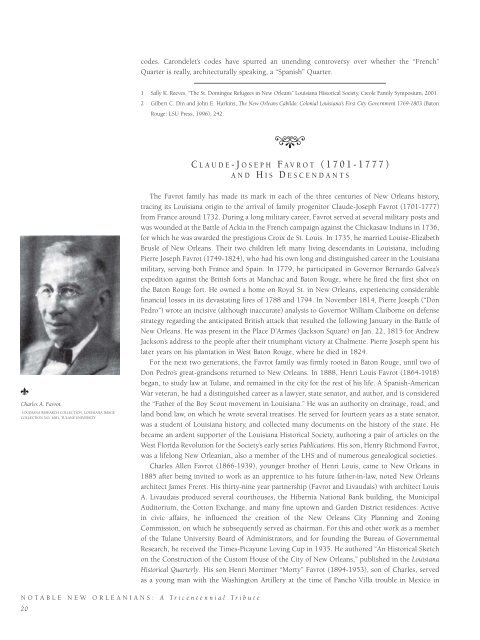Notable New Orleanians: A Tricentennial Tribute
An illustrated history of New Orleans paired with the histories of companies that have helped shape the city.
An illustrated history of New Orleans paired with the histories of companies that have helped shape the city.
You also want an ePaper? Increase the reach of your titles
YUMPU automatically turns print PDFs into web optimized ePapers that Google loves.
codes. Carondelet’s codes have spurred an unending controversy over whether the “French”<br />
Quarter is really, architecturally speaking, a “Spanish” Quarter.<br />
1 Sally K. Reeves, “The St. Domingue Refugees in <strong>New</strong> Orleans” Louisiana Historical Society, Creole Family Symposium, 2001.<br />
2 Gilbert C. Din and John E. Harkins, The <strong>New</strong> Orleans Cabildo: Colonial Louisiana’s First City Government 1769-1803 (Baton<br />
Rouge: LSU Press, 1996), 242.<br />
<br />
C LAUDE-JOSEPH F AVROT (1701-1777)<br />
AND H IS D ESCENDANTS<br />
<br />
Charles A. Favrot.<br />
LOUISIANA RESEARCH COLLECTION, LOUISIANA IMAGE<br />
COLLECTION NO. 1081, TULANE UNIVERSITY<br />
The Favrot family has made its mark in each of the three centuries of <strong>New</strong> Orleans history,<br />
tracing its Louisiana origin to the arrival of family progenitor Claude-Joseph Favrot (1701-1777)<br />
from France around 1732. During a long military career, Favrot served at several military posts and<br />
was wounded at the Battle of Ackia in the French campaign against the Chickasaw Indians in 1736,<br />
for which he was awarded the prestigious Croix de St. Louis. In 1735, he married Louise-Elizabeth<br />
Bruslé of <strong>New</strong> Orleans. Their two children left many living descendants in Louisiana, including<br />
Pierre Joseph Favrot (1749-1824), who had his own long and distinguished career in the Louisiana<br />
military, serving both France and Spain. In 1779, he participated in Governor Bernardo Galvez’s<br />
expedition against the British forts at Manchac and Baton Rouge, where he fired the first shot on<br />
the Baton Rouge fort. He owned a home on Royal St. in <strong>New</strong> Orleans, experiencing considerable<br />
financial losses in its devastating fires of 1788 and 1794. In November 1814, Pierre Joseph (“Don<br />
Pedro”) wrote an incisive (although inaccurate) analysis to Governor William Claiborne on defense<br />
strategy regarding the anticipated British attack that resulted the following January in the Battle of<br />
<strong>New</strong> Orleans. He was present in the Place D’Armes (Jackson Square) on Jan. 22, 1815 for Andrew<br />
Jackson’s address to the people after their triumphant victory at Chalmette. Pierre Joseph spent his<br />
later years on his plantation in West Baton Rouge, where he died in 1824.<br />
For the next two generations, the Favrot family was firmly rooted in Baton Rouge, until two of<br />
Don Pedro’s great-grandsons returned to <strong>New</strong> Orleans. In 1888, Henri Louis Favrot (1864-1918)<br />
began, to study law at Tulane, and remained in the city for the rest of his life. A Spanish-American<br />
War veteran, he had a distinguished career as a lawyer, state senator, and author, and is considered<br />
the “Father of the Boy Scout movement in Louisiana.” He was an authority on drainage, road, and<br />
land bond law, on which he wrote several treatises. He served for fourteen years as a state senator,<br />
was a student of Louisiana history, and collected many documents on the history of the state. He<br />
became an ardent supporter of the Louisiana Historical Society, authoring a pair of articles on the<br />
West Florida Revolution for the Society’s early series Publications. His son, Henry Richmond Favrot,<br />
was a lifelong <strong>New</strong> Orleanian, also a member of the LHS and of numerous genealogical societies.<br />
Charles Allen Favrot (1866-1939), younger brother of Henri Louis, came to <strong>New</strong> Orleans in<br />
1885 after being invited to work as an apprentice to his future father-in-law, noted <strong>New</strong> Orleans<br />
architect James Freret. His thirty-nine year partnership (Favrot and Livaudais) with architect Louis<br />
A. Livaudais produced several courthouses, the Hibernia National Bank building, the Municipal<br />
Auditorium, the Cotton Exchange, and many fine uptown and Garden District residences. Active<br />
in civic affairs, he influenced the creation of the <strong>New</strong> Orleans City Planning and Zoning<br />
Commission, on which he subsequently served as chairman. For this and other work as a member<br />
of the Tulane University Board of Administrators, and for founding the Bureau of Governmental<br />
Research, he received the Times-Picayune Loving Cup in 1935. He authored “An Historical Sketch<br />
on the Construction of the Custom House of the City of <strong>New</strong> Orleans,” published in the Louisiana<br />
Historical Quarterly. His son Henri Mortimer “Morty” Favrot (1894-1953), son of Charles, served<br />
as a young man with the Washington Artillery at the time of Pancho Villa trouble in Mexico in<br />
NOTABLE NEW ORLEANIANS: A <strong>Tricentennial</strong> <strong>Tribute</strong><br />
20
















